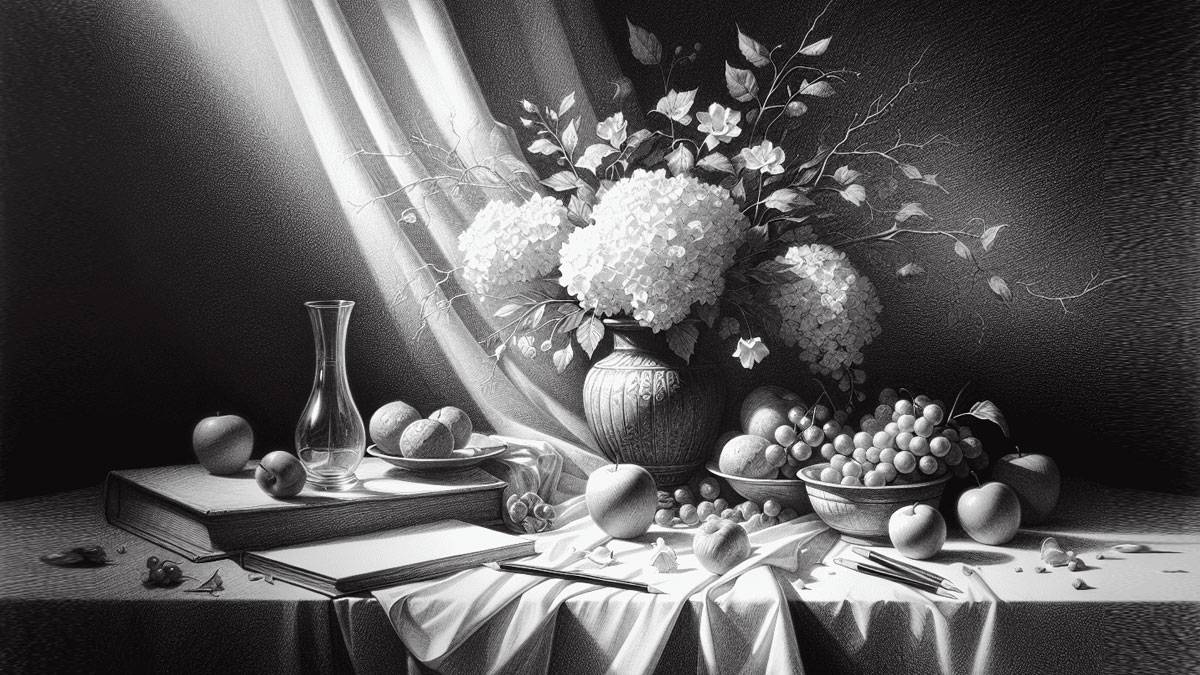Ever wondered how to make those everyday objects pop on your canvas with just a pencil? Dive into our guide on still life pencil drawing, where we spill the beans on techniques so simple yet so effective, your artwork will never be the same again. Prepare to amaze not just your friends, but yourself too!
Discover the Charm of Still Life Pencil Drawing
Embrace the Artist Within You
You’ve always felt that spark of creativity, that desire to create something beautiful with your own two hands. It’s time to embrace the artist that’s been waiting inside you, eager to express itself through the delicate strokes of a pencil. Imagine bringing a blank canvas to life with just a few well-placed lines and shades! Still life pencil drawing offers you that magical opportunity, and it’s more accessible than you might think. Whether you’re a seasoned artist or picking up a pencil for the first time, the journey into the world of drawing can be both thrilling and therapeutic.
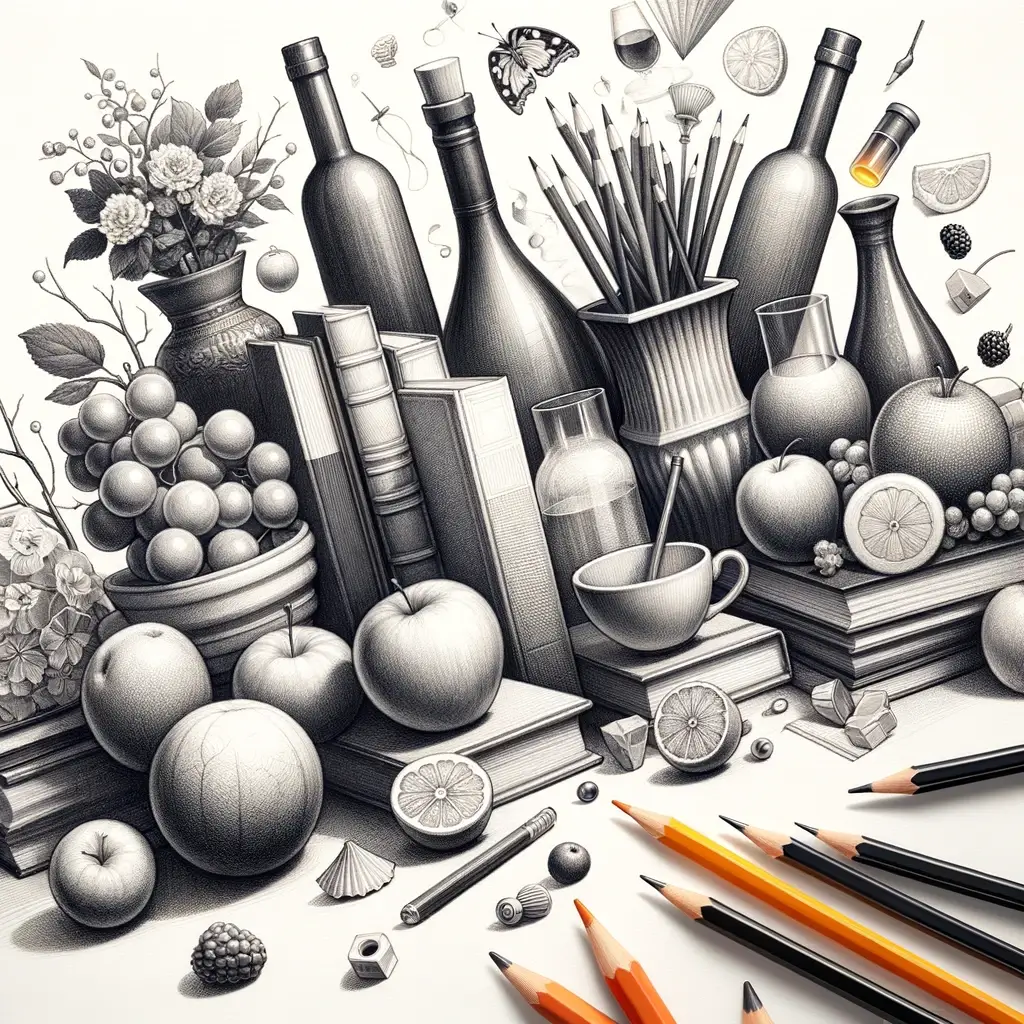
Why Still Life Drawing?
Still life pencil drawing is an enchanting gateway into the broader universe of art. It’s a place where you can start with the simplest of subjects and elevate them into works of art that tell a story or evoke an emotion. Why still life? Because it teaches you the fundamentals of drawing at your own pace. You learn about composition, light, shadow, and texture—all crucial skills that you can apply to any form of artistry, from realistic pencil drawing to whimsical colored pencil drawing.
Engaging in still life also allows you to appreciate the beauty in the ordinary. That apple on your kitchen counter isn’t just a snack—it’s a subject with curves, highlights, and shadows, waiting for you to capture its essence on paper. And the best part? You can start right now, with objects you have at home. Whether you’re interested in the elegance of natural subjects like pencil drawing of flowers and pencil drawing of fruit, or you want to tackle the complexity of man-made items like pencil drawing of cars or pencil drawing of boats, there’s a still life subject for you.
This form of art isn’t just about the final result; it’s about the journey. As you explore still life pencil drawing, you’ll find that it’s more than just a hobby—it’s a way to relax, to find joy in the quiet moments, and to see the world through a more artistic lens. Ready to begin? Let’s dive into the captivating world of still life, and together, we’ll unlock your inner artist. For guidance on your first steps, check out pencil drawing for beginners and prepare to be amazed at what you can create.
The Essentials of Still Life Pencil Drawing
Embark on a delightful journey of creativity with still life pencil drawing. Here, we explore the essentials that will set the foundation for your sketches and transform the way you approach your artwork.
Choosing Your Subject
Selecting the perfect subject for your still life pencil drawing is like picking the lead actor for your play – it sets the stage for your entire composition. Start with objects that intrigue you; they could be as simple as a piece of fruit, a vase, or an interesting bottle. The key is to find something that sparks joy and interest, as this will keep you engaged throughout the drawing process.
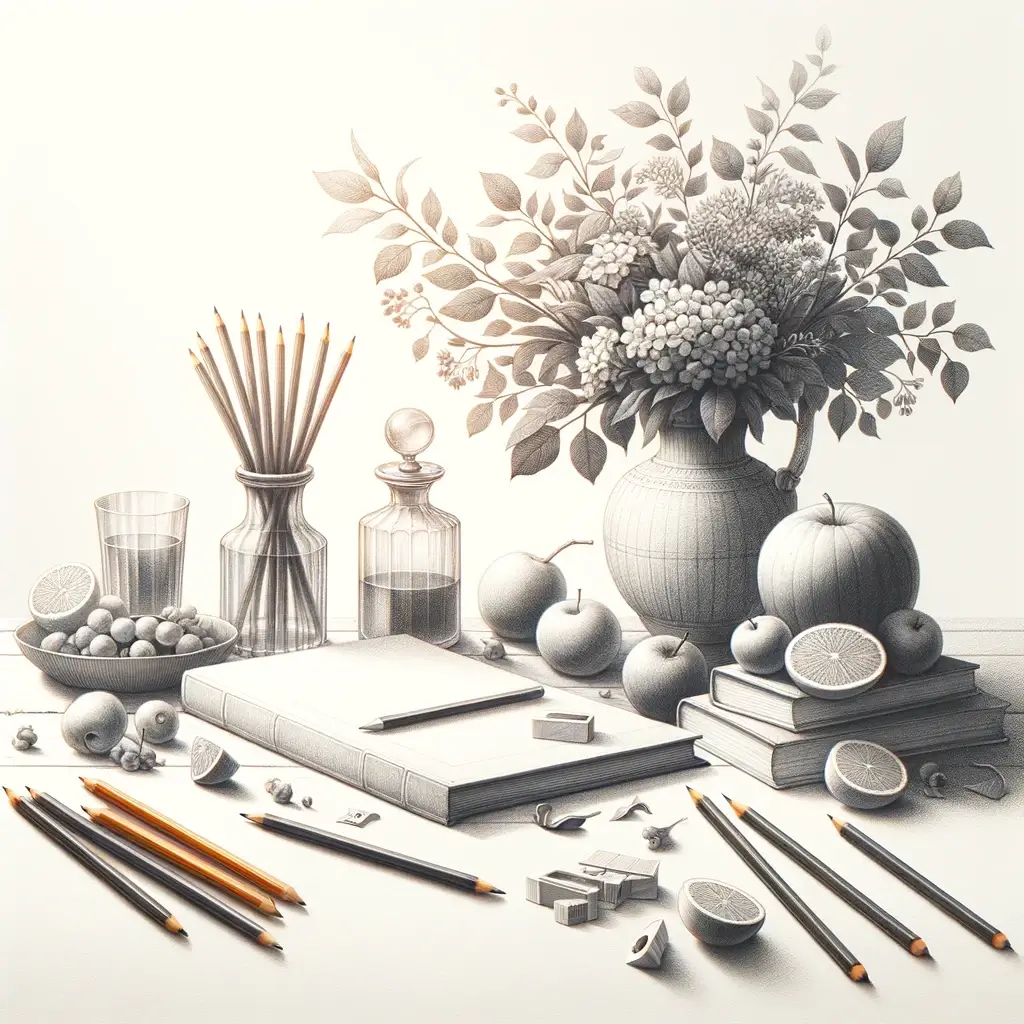
Think of the story you want to tell with your art. Do you want to depict the tranquility of a solitary object or the complexity of an arrangement? There’s a whole world of subjects to draw inspiration from, whether it’s a pencil drawing of flowers or the intricate details in pencil drawing of food. Remember, your choice will guide the mood and emotion of your work.
Understanding Composition and Perspective
Your still life’s composition is the arrangement of elements within your drawing space. It’s where you decide the layout and relationship between objects. Start by sketching thumbnails to play with different arrangements – consider the rule of thirds for a balanced look or try an asymmetrical composition for a more dynamic feel.
Perspective, on the other hand, gives your drawing a sense of depth and realism. It’s the art of replicating how objects appear smaller as they recede into the distance. For a beginner-friendly way to tackle perspective, check out our pencil drawing tutorials. They offer step-by-step guidance to master this skill.
The Importance of Light and Shadow
Light and shadow are the secret ingredients that bring your still life pencil drawing to life. They create form, depth, and a sense of realism. Observe how light interacts with your subject, note where the highlights and shadows fall, and use your pencils to replicate these effects.

To add volume to your objects, use shading techniques that range from light pressure for highlights to heavier pressure for deeper shadows. The contrast between light and dark areas will make your artwork pop. For a deeper dive into these techniques, explore our section on pencil drawing techniques.
Remember, mastering the essentials of still life pencil drawing opens up a world of possibilities. With each subject you choose, each composition you arrange, and each interplay of light and shadow you capture, you’re not just drawing; you’re breathing life into your sketches and telling a story that’s uniquely yours. Keep practicing, stay curious, and let your inner artist shine!
Getting Started with Pencil Drawing
Embarking on your artistic journey with still life pencil drawing is thrilling! It’s a practice that allows you to capture the essence of objects with simple tools. Let’s get you set up with the essentials you’ll need to begin and how to organize your creative space.
Basic Materials You’ll Need
To start your still life pencil drawing adventure, you’ll need a few basic materials. Here’s a quick list to help you gather your supplies:
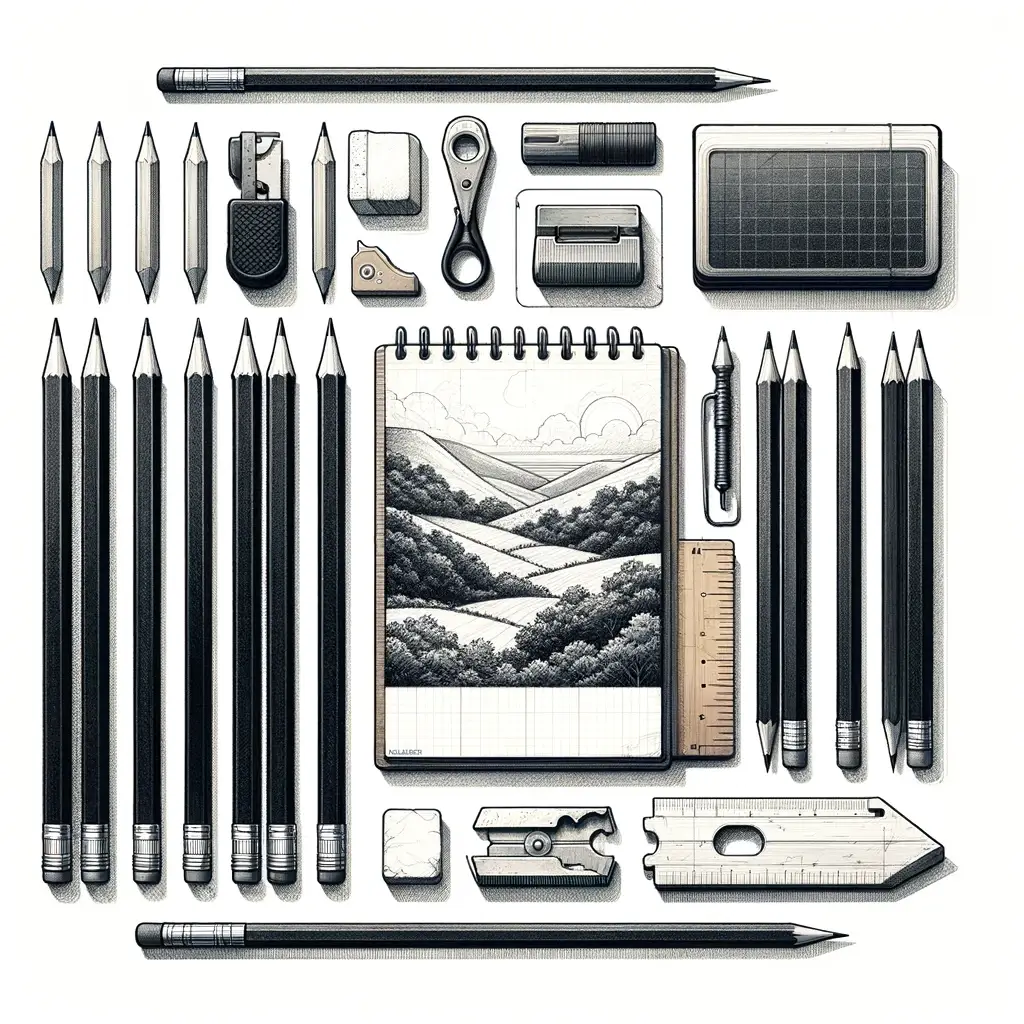
- Graphite Pencils: A range of pencils from hard (H) to soft (B) grades will give you the versatility to create different textures and shades. Look for a set that includes at least 2H, HB, 2B, 4B, and 6B pencils.
- Sketchbook: A good quality sketchbook with thick, durable pages is ideal for practicing and refining your technique. Consider one that’s at least 60-90 lb weight paper.
- Eraser: A kneaded eraser is perfect for gently lifting graphite from the page without damaging your work.
- Pencil Sharpener: Keep your pencils sharp for fine details. A manual sharpener is typically sufficient.
- Blending Stumps: Also known as tortillons, these are great for smoothing and blending your pencil work without getting graphite all over your fingers.
| Supply | Purpose |
|---|---|
| Graphite Pencils | For creating lines and shading |
| Sketchbook | To practice and compile your drawings |
| Eraser | To correct and refine your work |
| Pencil Sharpener | To maintain sharp pencil points |
| Blending Stumps | For blending graphite smoothly |
Feel free to explore pencil drawing for beginners for a more comprehensive guide on materials.
Setting Up Your Workspace
Your workspace is your sanctuary. It’s where the magic happens! Follow these tips to create a conducive environment for your still life pencil drawing:
- Find a Comfortable Spot: Choose a place that’s quiet and comfortable. A desk or table with ample space is ideal.
- Lighting Matters: Ensure your area is well-lit. Natural light is best, but if that’s not possible, a bright desk lamp will do the trick.
- Organize Your Materials: Keep your materials within easy reach. Use containers or holders to keep your pencils, erasers, and other tools organized.
- Inspiration at a Glance: Surround yourself with items that inspire you. This could be anything from a vase of flowers to intricate figurines.
Remember, your workspace should be a reflection of your personality and inspire creativity. For more tips on creating the perfect drawing environment, dive into pencil drawing techniques.
With your materials ready and your workspace set up, you’re all set to embark on your still life pencil drawing journey. Let your creativity flow, and enjoy the process of bringing still life to paper with your own unique touch.
Mastering the Techniques
As you journey deeper into the world of still life pencil drawing, mastering the essential techniques will elevate your art from simple sketches to stunning, detailed works. Let’s dive into the core skills that will help you bring your drawings to life!
Sketching Your Outline
The first step in your still life adventure is sketching the outline of your subject. Begin by lightly drawing the basic shapes, ensuring you capture the proportions accurately. It’s like creating a map for your artistic expedition!
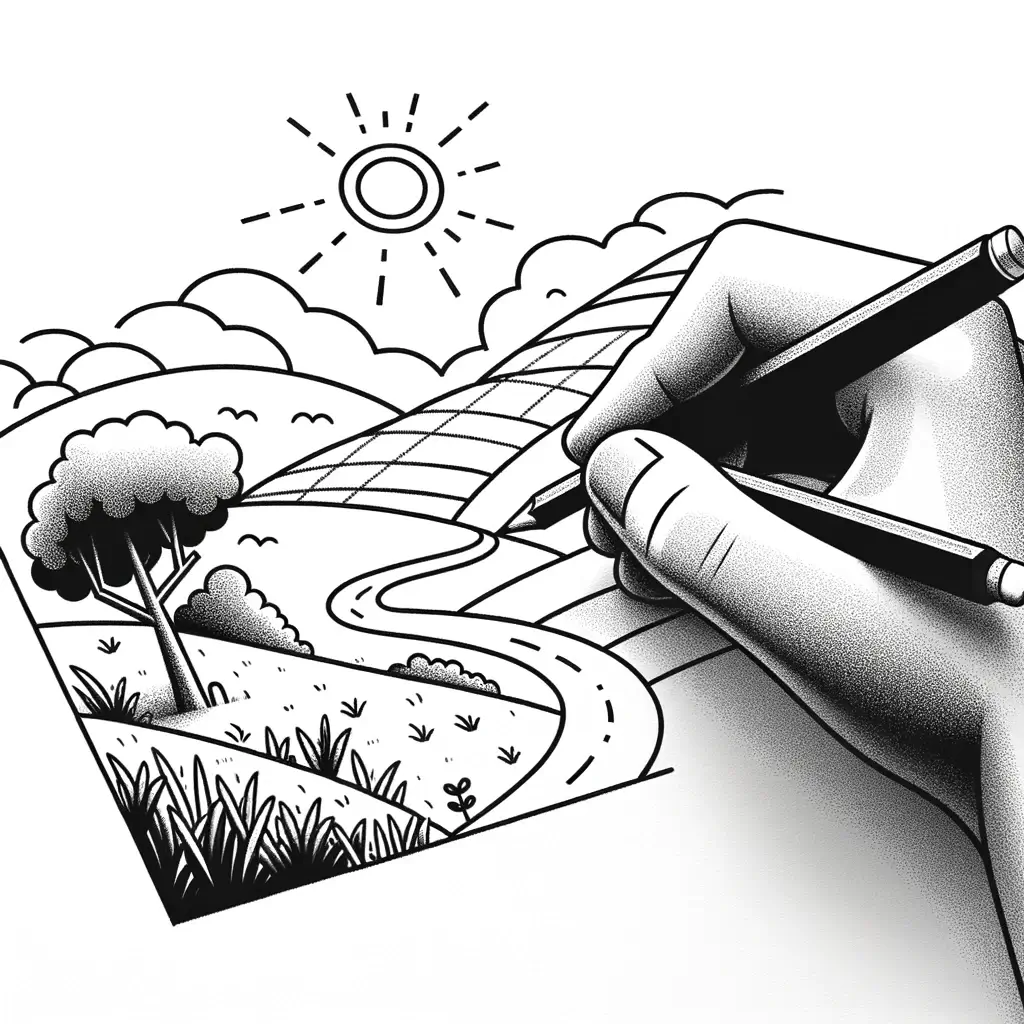
- Start with simple geometric shapes to form the basic structure.
- Keep your hand relaxed to avoid harsh lines that are difficult to erase.
- Use reference points within your subject to maintain accurate proportions.
Remember, this initial sketch is just a guide – you can refine as you progress. If you’re looking for more guidance, check out pencil drawing for beginners for helpful tips.
Techniques for Shading and Texture
Shading and texture give your still life pencil drawing depth and dimension. Imagine the sun casting shadows that dance over your subject, and replicate that interplay of light and dark on your paper.
- Hatching: Draw parallel lines closely together to create a shaded effect.
- Cross-hatching: Layer another set of lines over the first, creating a mesh-like pattern for deeper shades.
- Stippling: Use dots to build up texture and tone; more dots equal darker areas.
- Blending: Use a blending stump, tissue, or your finger to smooth out the pencil for a soft gradient.
Experiment with these techniques on different textures, whether it’s the roughness of tree bark or the smooth surface of a porcelain vase. Dive into pencil drawing techniques for a deeper exploration.
Refining Details for Realism
The magic in still life pencil drawing is in the details. Refining these tiny elements will inject realism into your art, making it nearly leap off the page.
- Focus on the subtle variations in light and shadow.
- Add the smallest of lines to suggest texture, like the delicate veins in a leaf.
- Pay attention to the highlights – they’re as important as the shadows for creating a three-dimensional effect.
The key is to observe and replicate the intricacies of your subject with patience and precision. Whether you’re working on a realistic pencil drawing of an apple or the delicate petals of a flower, each detail contributes to the overall lifelike quality.
By honing these techniques, you’ll be able to tackle any still life challenge, from the simplest of objects to the most intricate of scenes. Your still life pencil drawing skills will flourish as you practice, leading you to create pieces that are not only visually captivating but also emotionally engaging. Keep sketching, keep shading, and keep refining – your inner artist awaits the masterpieces you’ll produce!
Practicing Still Life Pencil Drawing
Embrace your creative journey with the whimsical world of still life pencil drawing. As you practice, you’ll discover the joy of transforming simple objects into stunning pieces of art. Let’s start with the basics and gradually build up the complexity of your compositions.
Simple Objects to Start With
Begin your artistic endeavor with objects that won’t overwhelm you. Look around your home for items like a coffee mug, an apple, or a pair of glasses. These objects have basic shapes that are easier to capture and will help you understand the fundamentals of form and shading.
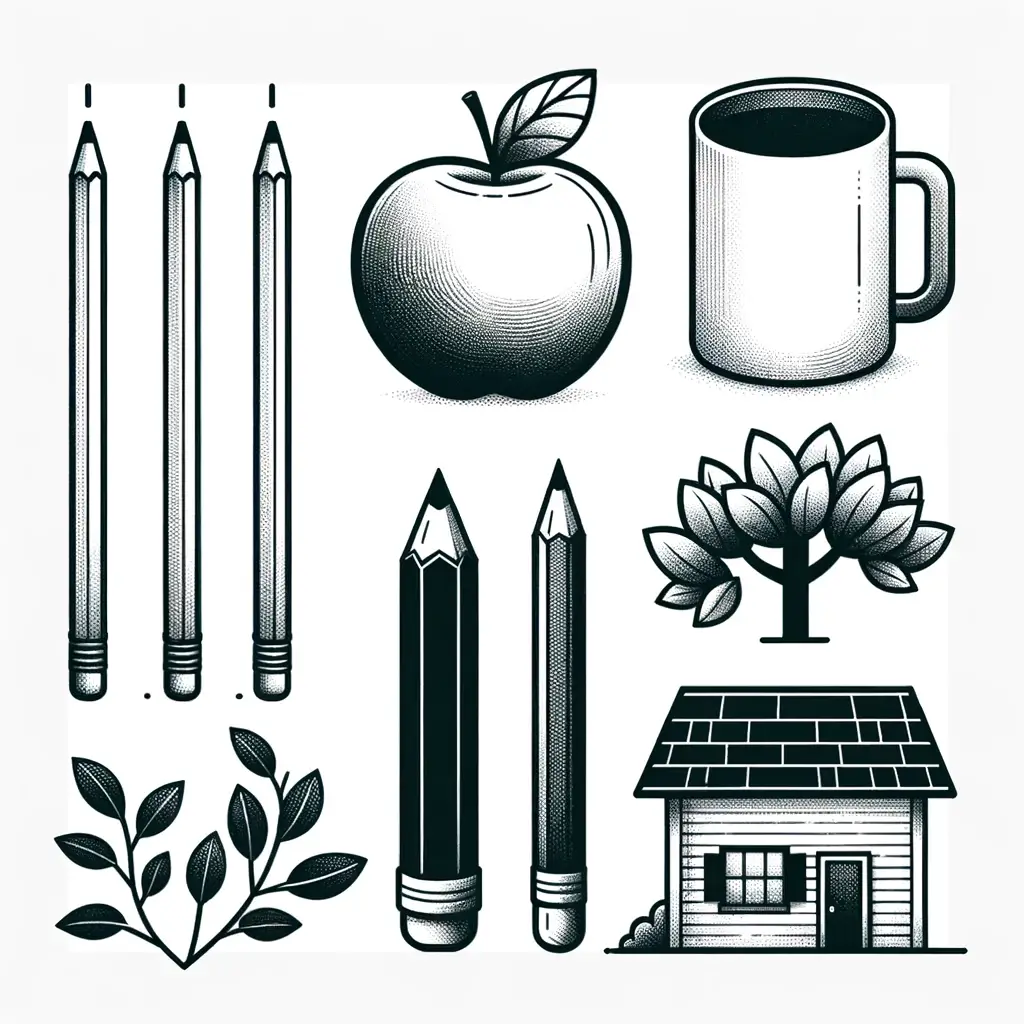
Here’s a fun exercise to get you started:
| Object | Shape | Key Features to Focus On |
|---|---|---|
| Apple | Round | Highlight and shadow to create volume |
| Mug | Cylindrical | Handle’s curve and shadow beneath the mug |
| Glasses | Oval and straight lines | Reflection on the lenses and the frame’s thickness |
As you become more comfortable with these forms, venture into realistic pencil drawing to challenge yourself further.
Building Complexity in Your Art
Once you’re confident with simple shapes, it’s time to add complexity to your still life drawings. Combine various objects with different textures like a velvety peach next to a shiny spoon. Experiment with compositions that tell a story or evoke a certain mood.
Incorporate elements from nature, like leaves or flowers, to add organic shapes and intricate details to your work. For inspiration on incorporating nature into your art, check out pencil drawing of flowers and pencil drawing of nature.
Keeping a Sketchbook
A sketchbook is your personal art playground. It’s a place where you can experiment with ideas, practice techniques, and document your progress. Make it a habit to draw regularly, even if it’s just for a few minutes each day. This will help you refine your skills and develop your unique style.
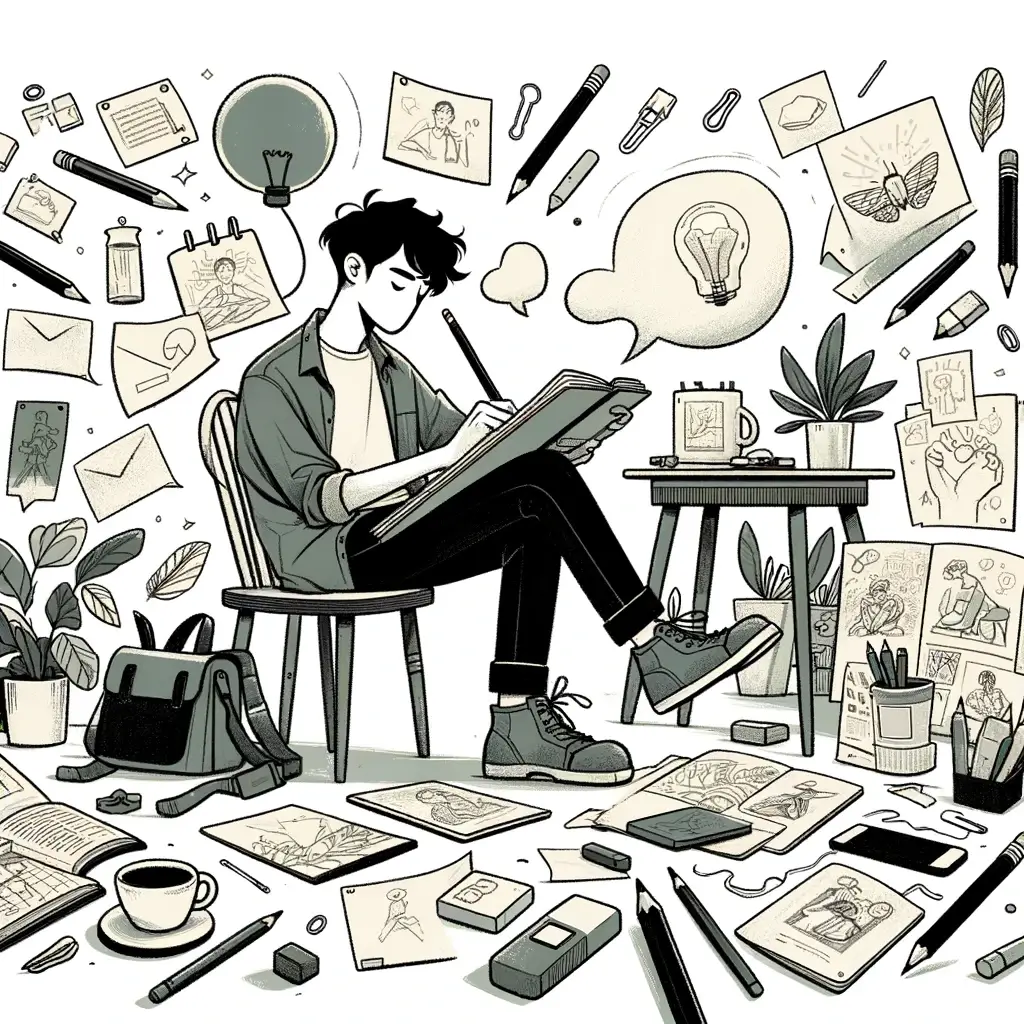
| Sketchbook Habit | Benefit |
|---|---|
| Daily Drawing | Improves muscle memory and hones skills |
| Trying New Subjects | Expands creativity and range |
| Reviewing Past Work | Allows for reflection and recognition of progress |
You can also use your sketchbook to explore different themes, such as animal pencil drawing or portrait pencil drawing. And if you ever feel stuck, a vast array of pencil drawing tutorials is available to guide you through new challenges.
Remember, each page of your sketchbook is a step forward in your artistic journey. So, grab your pencils, and let’s turn the mundane into the magnificent with every stroke!
Overcoming Common Challenges
When embarking on the exciting journey of still life pencil drawing, you might encounter a few roadblocks along the way. Fear not! Let’s tackle some common challenges head-on and keep your artistic spirit soaring.
Achieving Proportions
Accurate proportions are the foundation of any realistic drawing. It can be frustrating when your fruit looks more like a balloon, or your vase resembles a squished marshmallow. But, with a few simple tricks, you’ll have your drawings looking proportionate and pleasing to the eye.
Start by observing the basic shapes that make up your subject. A helpful technique is to use a grid method, where you draw a grid over your reference photo and replicate it on your drawing paper, helping to map out proportions accurately. This can be especially useful for portrait pencil drawing or when capturing the intricate details of wildlife.
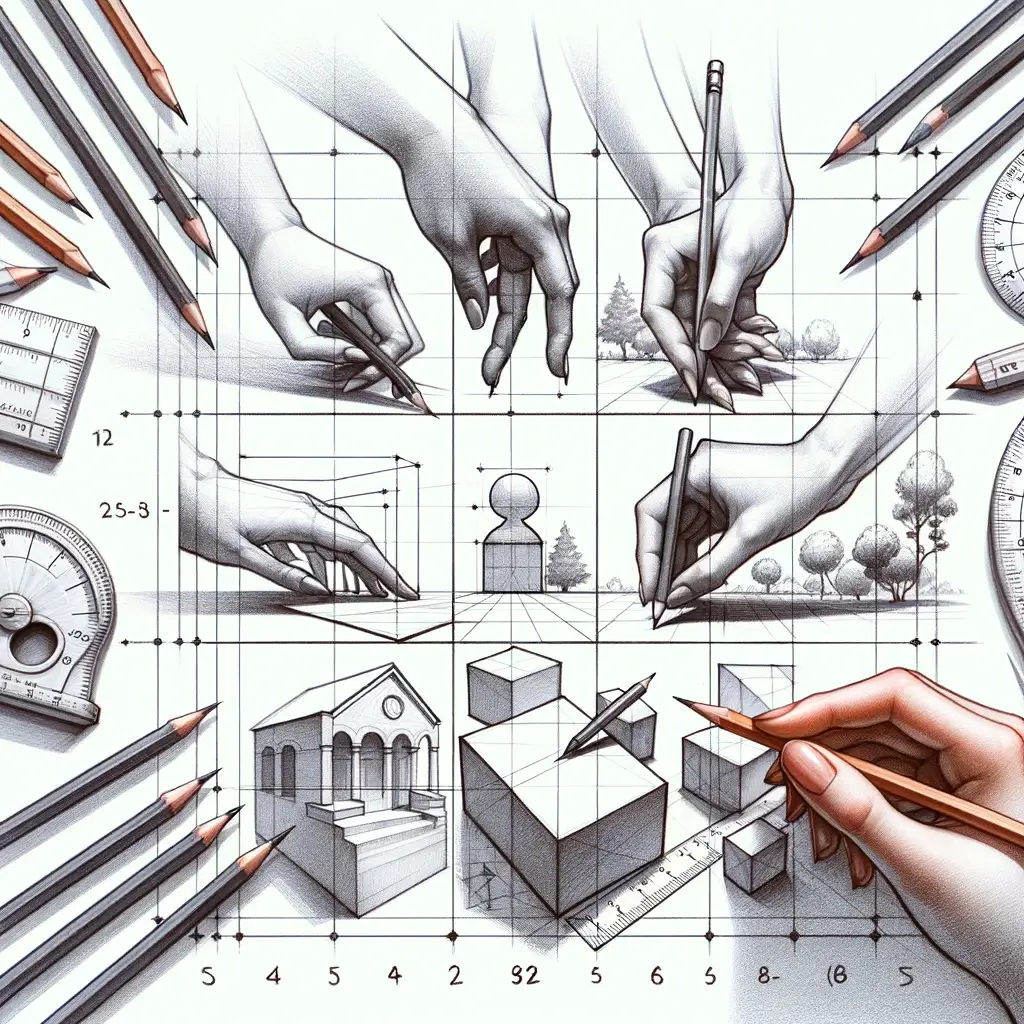
Another tip is to constantly compare sizes within your drawing. The width of an object should be considered in relation to its height, and both should be compared to the objects around it. Keep stepping back from your work to gain a fresh perspective and make any necessary adjustments. Remember, practice makes perfect, and there’s no rush in the world of pencil drawing for beginners.
Controlling Pencil Pressure
The pressure you apply to your pencil can dramatically affect the tone and texture of your drawing. A heavy hand might lead to a darker, more dramatic effect, while a lighter touch can create a soft and subtle look.
It’s crucial to get comfortable with varying your pencil pressure to achieve different effects. Try practicing on a scrap piece of paper, creating a gradient scale from light to dark. This will give you a better feel for how much pressure to apply for the desired result.
When starting your still life, use light pressure to sketch the initial outline. You can then build up the darkness and intensity gradually, which is easier to control and less intimidating than going in with a heavy hand. If you’re looking to dive deeper into techniques, check out our pencil drawing techniques guide.
Creating Depth in Your Drawings
A flat drawing lacks life and realism. Creating depth is essential to make your still life pop off the page. This can be achieved by mastering light and shadow, as well as understanding the principles of perspective.
For shadows, take note of where your light source is coming from and use shading to mimic how the light falls on your objects. The parts that are furthest from the light will be the darkest, while those closest to the light remain lighter. Consider exploring charcoal pencil drawing for a dramatic play on light and shadow.
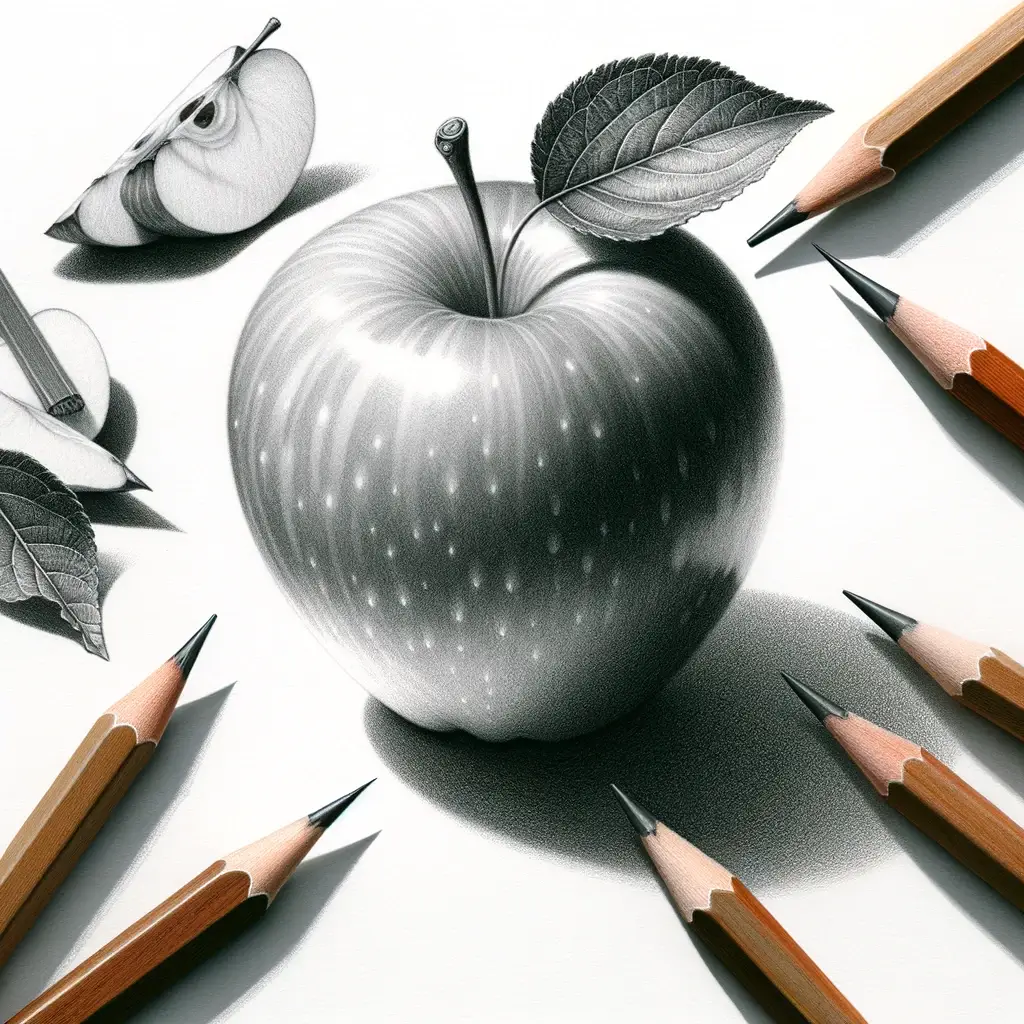
Perspective is another key factor in adding depth. Objects that are further away should be smaller and less detailed than those at the front. Overlapping elements in your drawing also helps to create a sense of space. For a detailed exploration on this subject, our landscape pencil drawing tutorial can offer valuable insights.
These tips will help you navigate the common challenges of still life pencil drawing. Embrace each hurdle as a learning opportunity, and remember that every artist has been in your shoes. Keep experimenting with different subjects, from the simplicity of pencil drawing of food to the intricate contours of pencil drawing of flowers. Your dedication and enthusiasm will shine through your artwork, making each piece uniquely yours.
Finding Inspiration for Your Still Life Drawings
Unleashing your creativity in still life pencil drawing starts with finding the right inspiration. Whether you’re drawn to the mundane, the majestic, or a mix of both, there’s a world of possibilities waiting for your pencil to bring them to life.
Everyday Objects with a Twist
Look around you; inspiration can be found in the most ordinary objects. Your kitchen, for example, is a treasure trove of shapes and textures. An apple isn’t just an apple—it’s a study of color gradients and reflections. A teacup isn’t just a teacup—it’s a lesson in symmetry and shadow.
Try reimagining these common items by placing them in unusual contexts or combining them in quirky ways. A bunch of bananas might be transformed into a boat floating on a sea of blue fabric. The key is to twist the familiar into something extraordinary, sparking interest and narrative in your still life pencil drawing.

| Object | Twist Idea |
|---|---|
| Apples | Color gradient study |
| Teacup | Symmetry and shadow |
| Bananas | Imaginary boat on fabric sea |
For more whimsical ideas, explore pencil drawing of food and let your imagination run wild.
Nature as a Timeless Muse
Nature’s diversity offers endless inspiration for your artwork. From the delicate veins of a leaf to the rugged bark of an old tree, each element is a microcosm of patterns and forms. Wander through a garden, a park, or a forest and you’ll find subjects that speak to you, begging to be captured on paper.
Consider the seasons as well—each brings its own unique beauty. An autumn leaf with its fiery hues, a winter branch encased in ice, each tells a story of change and resilience.
For those who love the great outdoors, take a peek at landscape pencil drawing or pencil drawing of nature for scenes that evoke the spirit of the wild.
Drawing from Photographs vs. Real Life
While drawing from life provides a richness of detail and depth, not everyone has access to a vase of flowers or a bowl of fruit at all times. This is where photographs can be invaluable. They freeze a moment in time, allowing you to study it for as long as you need. Plus, you can find images of objects from around the world that you might not be able to see in person.

However, it’s important to remember that photographs can sometimes flatten your perspective. Drawing from life challenges you to interpret the three-dimensional world, translating it onto a two-dimensional surface. It’s a skill that, once honed, will elevate your realism to new heights.
To balance both approaches, why not start with pencil drawing tutorials that guide you through the process of transforming a photo into a lifelike drawing?
In still life pencil drawing, your inspiration can be as simple or as complex as you wish. Whether you’re sketching the grooves in a seashell or the intricate mechanics inside a watch, every drawing is a step on your artistic journey. So grab your pencils and let the world around you spark the creativity within your art.
Sharing Your Art with the World
Once you’ve honed your skills in still life pencil drawing, it’s time to step out of your comfort zone and share your creations with the world. It’s an exhilarating part of your artistic journey that connects you with like-minded individuals and opens up a whole new realm of possibilities.
Giving and Receiving Constructive Feedback
The exchange of constructive feedback is a cornerstone of artistic growth. When presenting your work, be open to receiving critiques from peers and mentors. Equally important is learning how to provide constructive feedback to fellow artists. A well-rounded critique should highlight strengths and suggest areas for improvement without discouraging the artist. Engaging in this practice helps you develop a critical eye for your own work and fosters a supportive community that thrives on mutual development and inspiration.
Remember, every piece you create is a step forward in your artistic journey. Embrace the opportunities to learn, share, and connect with others who share your passion for pencil drawing. Whether you’re interested in landscape pencil drawing, portrait pencil drawing, or branching out to hyperrealistic pencil drawing, a community and platform is waiting for you. Share your still life pencil drawings and let the world see the world through your eyes.

